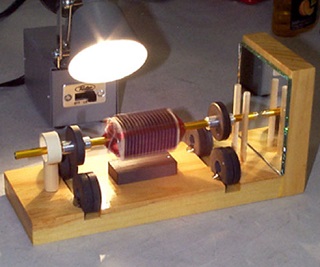Solar-Powered Motor

There are a few things you need to understand:
• The power derived from solar PV is proportional to the surface area exposed.
• The Earth receives about 1000 Watts / square meter.
• PV is about 20% efficient, meaning that we get 200 Watts / square meter = about 1/4 horsepower (less inefficiencies, which will be significant.)
• There is some math (that I’ll leave out) associated with the fact that most of the incident sunlight strikes the motor at various oblique angles.
The net of this is that a machine of this type that could generate 100 horsepower would sit on several acres, rendering it supremely impractical to power a car. Sorry.

Creating interesting and fun projects such as this one are an essential element of personal development, and particularly for the young.
There is a great sense of achievement in seeing an idea work as expected; or hoped, and there is really nothing more rewarding personally than creativity that delivers an intended outcome.
If we as onlookers ever feel inclined to take this away by discouragement or ridicule, we may be contributing to irreparable damage to the experimenters mental health, ongoing development and self-esteem.
So Copernicus bravo for your wonderfully creative Solar Powered Motor project, and thank you for sharing.
What this project tells me about you Copernicus is that one day we will be hearing much more about you as you focus on grander technology designs that tick off many more boxes that are required to be ticked off in commercially viable technology design, but of course at the moment these design imperatives are irrelevant to your current creative and fun Solar Powered Motor project.
Keep up the good work Copernicus and all the best as you move forward.
Lawrence Coomber
Sometimes “interesting and fun” can also be misleading. Witness the 1000’s of questions asking why we can’t attach a generator to an electric car to make it go forever. This project reminds me a great deal of “magnetic motors” which shows a great deal of misunderstanding about flywheel energy storage.
Well said Lawrence you found the Sunny Silver Lining trust your Academy is moving along we need more energy inventions….
In the right area, solar could make a useful range extending contribution. A car could feature around 1 kW of panels, which in a place like Australia might collect around 4 kWh per day.
In a lightweight electric vehicle optimised for range, this could take you perhaps 20 miles per day.
A driver who’s main vehicle usage is a short commute of 5 miles each way would seldom have to plug their vehicle in!
For very lightweight low speed vehicles such as solar powered rickshaws, a reasonable daily range can be achieved – especially with some pedal assist. Such vehicles are now available from an Australian company operating in Cambodia.
At present efficiencies, solar panels for a typical commercial electric vehicle could increase the vehicle range no more than about 3 miles / each hour left in the sun (if the entire surface of the vehicle were covered in panels.)
The Nissan Leaf does about 5 miles per kWh. Sunman has introduced the lightweight and flexible eArche solar panels, producing 200W with an 8 sq ft panel. A 1.6 kW 88-lb array could produce 7.2 kWh per day, enabling a 36 mile daily commute.